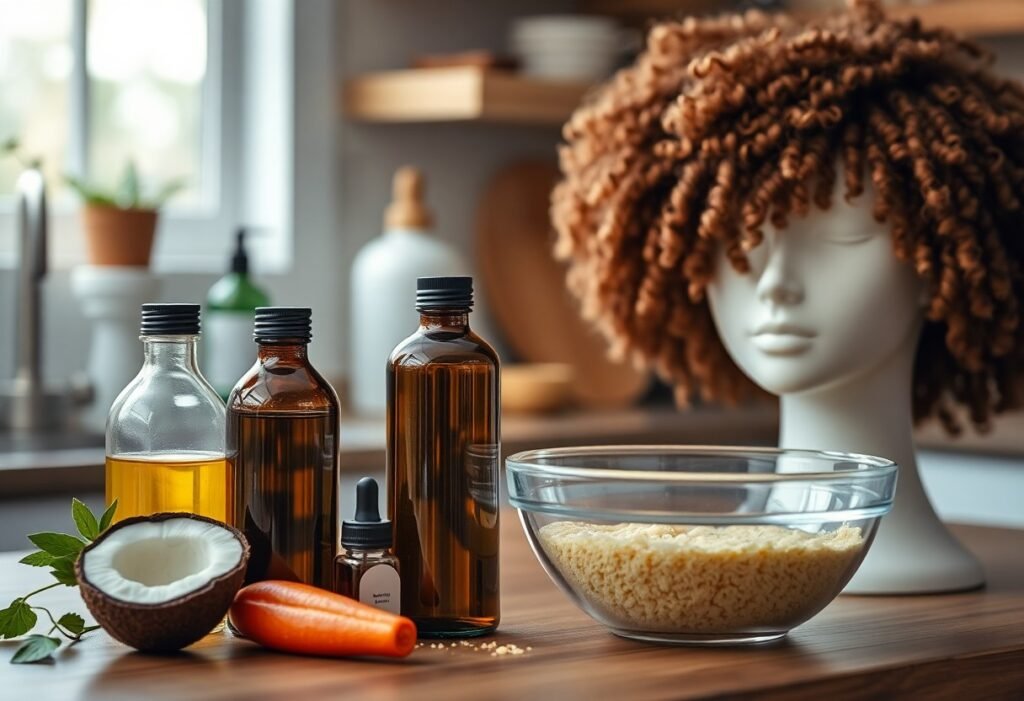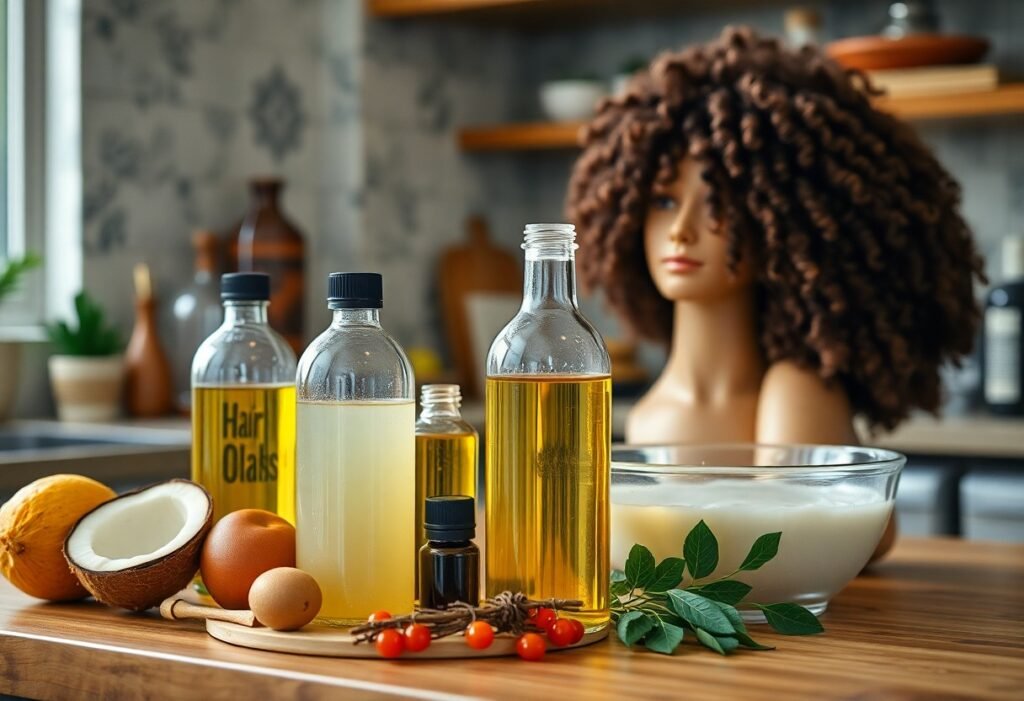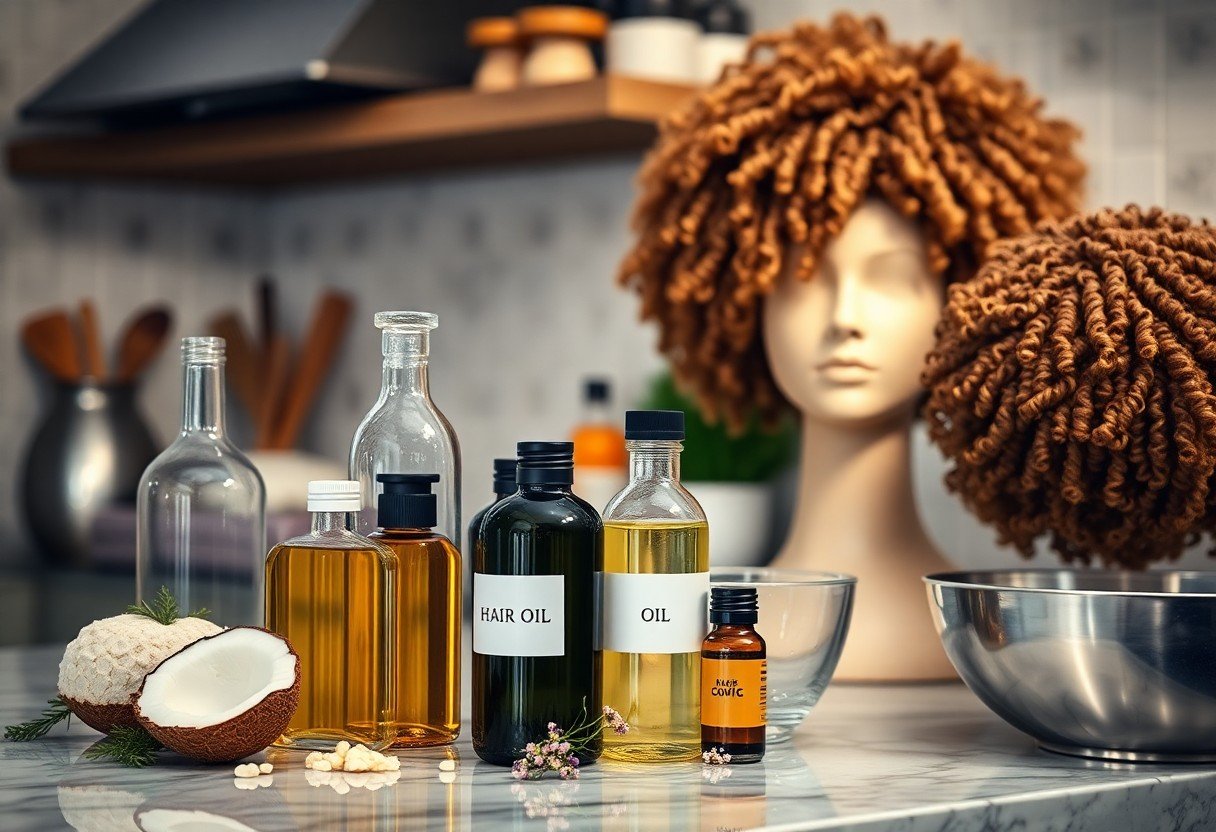DIY hair oils can be a game changer for your curly locks, transforming them into soft, vibrant tresses that shine. You can make hair oil for curly hair at home using natural ingredients, avoiding the harmful chemicals often found in commercial products. In this guide, you’ll discover four simple recipes that will enhance your curls’ health and beauty. With a little effort, you can achieve stunning curls that are not only manageable but also deeply moisturized and full of life.
Types of Hair Oils for Curly Hair
Your curly hair thrives on moisture, and using the right type of hair oil can help enhance its natural beauty. Here are some types of oils you can incorporate into your curly hair routine:
- Argan Oil
- Coconut Oil
- Jojoba Oil
- Olive Oil
- Castor Oil
Thou can enjoy healthier and more vibrant curls by choosing oils that suit your hair’s needs.
| Type of Oil | Benefits |
|---|---|
| Argan Oil | Rich in fatty acids, hydrates and nourishes hair. |
| Coconut Oil | Pentrates hair shaft, reduces protein loss and adds moisture. |
| Jojoba Oil | Mirrors natural scalp oils, promoting balance and hydration. |
| Olive Oil | Deeply moisturizes, adds shine, helps tame frizz. |
| Castor Oil | Encourages hair growth and adds thickness. |
Nourishing Oils
With nourishing oils, you can deliver necessary nutrients directly to your curls, helping them remain hydrated and healthy. These oils often include coconut and argan oil, both renowned for their ability to penetrate the hair shaft. Incorporating these oils into your hair care routine can repair damage, minimize frizz, and enhance your curl pattern.
Lightweight Oils
One way to avoid weighing down your curls is by using lightweight oils that provide moisture without adding excessive heaviness. These oils are perfect for maintaining volume while delivering necessary hydration.
Curly hair often benefits from lightweight oils like jojoba and grape seed oil, which absorb quickly and won’t leave your hair feeling greasy. Utilizing these oils can help balance moisture levels, enhance shine, and prevent dryness while keeping your curls bouncy and defined.
Explore: How to Oil Curly Hair Overnight: The Complete Guide
Essential Tips for Using Hair Oils
There’s a lot to gain from incorporating hair oils into your routine for healthy, stunning curls. To maximize the benefits, consider these tips:
- Warm the oil slightly before application for better absorption.
- Focus on the ends of your hair, where moisture is most needed.
- Combine different oils for a customized blend that suits your hair type.
- Apply oil on damp hair to lock in moisture.
The right techniques can transform your curls, enhancing their natural beauty. For a unique blend, check out this Herbal Hair Oil with Rosemary, Nettles, and Rose.
Application Techniques
If you’re new to using hair oils, start by applying a small amount to your palms, rubbing them together, and then gently scrunching the oil into your curls. This method helps ensure that the oil is evenly distributed without weighing down your hair. You can also use your fingertips to massage the oil into your scalp, promoting healthy hair growth while giving your curls the moisture they need.
Frequency of Use
To keep your curls healthy and well-moisturized, aim to use hair oils at least once or twice a week. Adjust the frequency based on your hair’s individual needs and how oily it becomes after application. Using hair oils consistently will help you maintain hydration and shine, leading to softer and more manageable curls. Pay attention to how your hair reacts; if you notice excessive oiliness, reduce the frequency, and if it feels dry, you may want to increase it. Finding a balance is key to achieving the perfect curly hairstyle!
Step-by-Step Guide to Making Your Own Hair Oil
If you’re ready to nurture your curly hair with a DIY oil blend, follow these simple steps. Creating your own hair oil allows you to customize it with ingredients that specifically cater to your hair’s needs, ensuring shine, hydration, and manageability. Below is a breakdown to help you get started:
| Step | Action |
|---|---|
| 1 | Choose your base oil (e.g., coconut, jojoba, or olive oil). |
| 2 | Add necessary oils suited for curly hair (like rosemary or lavender). |
| 3 | Mix thoroughly in a glass container. |
| 4 | Store your creation in a cool, dark place. |
Choosing Ingredients
An effective hair oil blend begins with selecting the right ingredients. Opt for carrier oils that nourish and moisturize your hair, such as coconut oil for hydration or jojoba oil for its ability to mimic natural scalp oils. Enhance your mixture with necessary oils like rosemary and lavender, known for promoting shine and improving hair health. Tailor these choices to match your unique hair care goals.
Preparation Methods
For making your hair oil, you have multiple preparation methods to choose from. From simple mixtures to infused oils, the method you select can greatly impact the benefits you derive. Whether you blend oils directly or infuse them with herbs for added potency, each approach offers unique advantages tailor-fit to your hair care routine.
Explore: What Does Hair Oil Do for Curly Hair?
Understanding the preparation methods allows you to customize your hair oil’s efficacy. Infusion involves steeping herbs or flowers in carrier oils for an extended period, harnessing their full benefits. On the other hand, a simple mix of carrier and necessary oils offers immediate nourishment. Whichever method you choose, ensure it aligns with your hair’s needs for optimal results.

Factors to Consider When Choosing Hair Oils
All hair oils are not created equal, especially when it comes to caring for curly hair. You’ll want to consider a few imperative factors to find the oil that best suits your needs:
- Ingredient quality and purity
- Your hair’s specific needs (hydration, shine, frizz control)
- Compatibility with your hair type and texture
- Presence of imperative oils for added benefits
Any of these considerations will guide you toward the right oil for healthy, beautiful curls.
Hair Type and Texture
When opting for hair oils, it’s important to assess your unique hair type and texture. Curly hair often requires more moisture and nourishment due to its tendency to be drier and more prone to frizz. Choose lightweight oils like argan or jojoba for fine curls, while thicker oils like coconut or olive oil work well for coarser textures.
Specific Hair Concerns
Even with healthy curls, you may face specific hair concerns that need addressing. Factors such as dryness, damage, color-treated hair, or scalp issues may dictate the type of oil you should use. It’s imperative to choose oils that target these particular problems while also nourishing your curls.
Hair oils, particularly those infused with specific imperative oils, can effectively address various concerns. For instance, if you’re battling dryness, oils rich in fatty acids can restore moisture and elasticity. If your scalp is itchy or flaking, look for oils that contain tea tree or peppermint for soothing relief. By identifying your specific hair issues, you’ll be better equipped to select an oil that enhances your curly hair’s overall health and vitality.

Pros and Cons of Using Hair Oils
Unlike conventional hair products, hair oils can offer a range of benefits tailored to your unique curly locks. However, it’s crucial to weigh the pros against the cons to make an informed choice for your hair care routine.
| Pros | Cons |
|---|---|
| Moisturizes dry curls | Can make hair greasy if overused |
| Reduces frizz and enhances shine | May weigh down finer hair types |
| Improves hair texture | Potential for buildup if not washed out properly |
| Natural ingredients promote healthy growth | Some oils can cause allergic reactions |
| Customizable blends for specific needs | May require experimentation to find the right one |
Benefits for Curly Hair
Any hair oil you choose can significantly enhance the health of your curly hair, providing hydration and smoothing out frizz. These oils work by sealing in moisture, promoting shine, and nurturing your curls from root to tip. Plus, by using natural ingredients, you avoid harmful chemicals found in many commercial products that can lead to dryness and damage over time.
Potential Drawbacks
Hair oils can have downsides that you should consider during your hair care journey.
Understanding how hair oils interact with your specific curl type is crucial. For example, while oils can provide much-needed moisture, using too much can lead to a greasy appearance or weigh down finer curls. Additionally, if you don’t wash your hair thoroughly or use a clarifying shampoo occasionally, you might experience buildup that affects the way your curls bounce. It’s important to find the right balance to achieve healthy, stunning curls without the drawbacks of using hair oils.
Explore: Best hair oil for curly frizzy hair : Expert Recommendations for Hydrated Locks

Recommended DIY Hair Oil Recipes
Now you can elevate your hair care routine with these simple DIY hair oil recipes, specifically designed to nourish and enhance your beautiful curls. These blends not only provide hydration but also help combat frizz and boost shine, leaving your curly hair healthy and stunning. Dive into these easy-to-make recipes to discover how they can make a difference in your hair care regimen.
Hydrating Oil Blend
With a combination of coconut oil and necessary oils, this hydrating oil blend deeply moisturizes your curls, helping to eliminate dryness and frizz. Simply mix the oils together and apply it to your scalp and hair, ensuring even coverage for optimal hydration.
Shine-Boosting Oil Mix
While enhancing shine, this oil mix serves as a fantastic solution for dull and lifeless curls. It utilizes ingredients like rosemary necessary oil mixed with a carrier oil to promote luster and encourage hair growth. Apply it before styling or as a finishing touch for radiant curls.
Recommended for those looking to revive dull curls, the Shine-Boosting Oil Mix not only enhances shine but also contributes to your hair’s overall health. Incorporating rosemary necessary oil can provide your strands with a nutrient boost, helping them reflect light better and appear shinier. Use this mix regularly for a noticeable difference in your curly hair’s vitality.
Final Words
Considering all points, creating your own hair oil and incorporating these four easy DIY recipes can transform your curly hair into a healthy, beautiful mane. By using natural ingredients like crucial oils and hydrating agents, you can effectively combat dryness and frizz while promoting growth and shine. Embracing these homemade solutions empowers you to take control of your hair care routine, ensuring your curls look stunning and vibrant. Enjoy the process of crafting tailored treatments that suit your hair’s unique needs for truly radiant results.
FAQ
Q: What ingredients are best for making hair oil for curly hair?
A: When creating a hair oil for curly hair, it’s ideal to use nourishing oils that hydrate and control frizz. Some great options include coconut oil, jojoba oil, olive oil, and argan oil. Additionally, incorporating necessary oils such as lavender, rosemary, and chamomile can enhance your oil blend by adding beneficial scents and properties. These oils help retain moisture and promote healthy hair growth while ensuring your curls stay soft and manageable.
Q: How do I apply homemade hair oil to my curls?
A: To effectively apply homemade hair oil, start by warming a small amount of the oil blend in your hands. Rub your palms together and then gently distribute the oil through your damp or dry curls, focusing on the ends where they’re most prone to dryness. Use your fingers or a wide-tooth comb to ensure even coverage, and avoid applying too much oil to your scalp to prevent greasiness. For best results, consider doing this after washing your hair or as a part of your nighttime routine.
Q: How often should I use hair oil for curly hair?
A: The frequency of using hair oil largely depends on your hair type and personal preference. For most curly hair types, using hair oil 1-3 times a week works well. If you have particularly dry hair, you might benefit from more frequent applications, either as a leave-in treatment or a pre-wash oiling. Pay attention to how your hair reacts—adjust the frequency based on whether your curls feel moisturized or too greasy.
Q: Can I create a leave-in conditioner using necessary oils?
A: Absolutely! You can create a simple leave-in conditioner by mixing necessary oils with a carrier oil or water. For a nourishing leave-in spray, blend 1/4 cup of vegetable glycerin, 1/2 cup of witch hazel, and a few drops of your favorite necessary oils (such as lavender or clary sage). Shake well and spritz it onto your curls after washing your hair to keep them hydrated and frizz-free throughout the day.
Q: What are some benefits of using necessary oils in hair care?
A: Essential oils offer a wide range of benefits for hair care. They can help soothe the scalp, prevent dandruff, boost shine, and promote hair growth. Oils like rosemary enhance luster while lavender provides a calming scent and reduces dryness. Additionally, many necessary oils have antibacterial and antifungal properties that keep your scalp healthy and balanced. Incorporating these oils into your routine can lead to healthier, softer, and more manageable curls.

